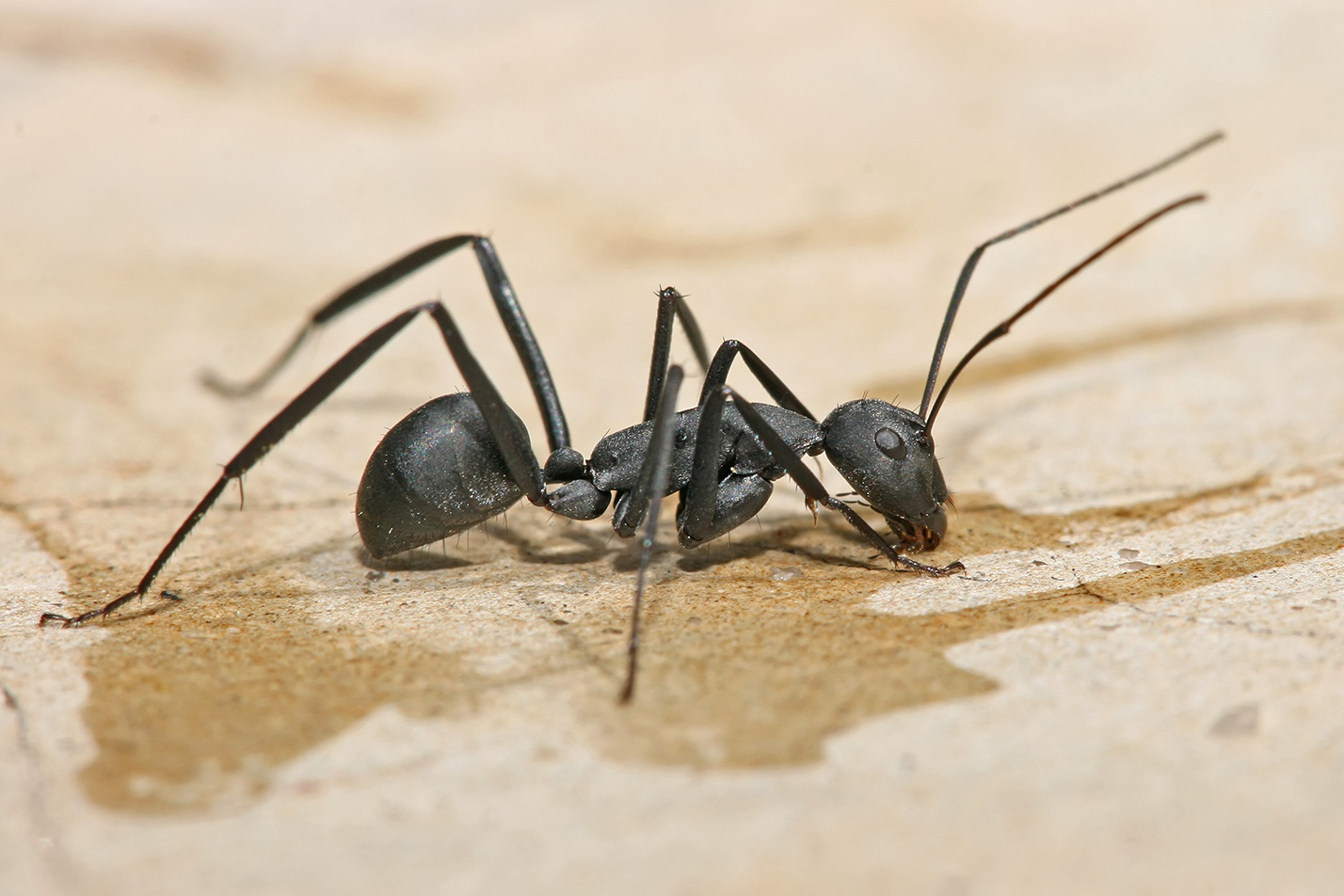|
Brachymyrmex
''Brachymyrmex'' is a genus in the ants subfamily Formicinae. The genus can be recognized by the combination of having nine antennal segments (fewer than most ants) and the petiole concealed by the gaster in dorsal view. They are sometimes called "rover ants". Distribution The genus has a mainly Neotropical distribution, ranging from the United States to Argentina and Chile, including the Caribbean islands, but some species have been introduced to Japan, and Madagascar. Description ''Brachymyrmex'' is a genus of minute ants that at first glance exhibit little morphological variation. Currently only the 9-segmented antennae and lack of antennal club have been proposed to diagnose workers of the genus. The combination of small size, soft metasoma, and the simple morphology makes observations and interpretation of morphological characters difficult. These difficulties impede taxonomic revisions and even led Creighton (1950) to call ''Brachymyrmex'' a "miserable little genus". Never ... [...More Info...] [...Related Items...] OR: [Wikipedia] [Google] [Baidu] |
Brachymyrmex Patagonicus
''Brachymyrmex patagonicus'', also known as the black rover ant, is a species of Formicine ant native to Mexico, Central America, South America, and invasive in the United States and Europe. They were first reported in St. Tammany Parish, Louisiana in 1978 from a single colony collected in 1976. It is believed that the species was introduced through New Orleans, which is a common entry point for many tropical species, but other locations such as Mobile, Alabama, or Pensacola, Florida, are also likely. For many years ''B. patagonicus'', ''B. musculus'', and ''B. obscurior'' were misidentified as being separate species but after a comparison of specimens from the Louisiana State University Arthropod Collection (LSUC), it was found that all three were the same species. ''B. patagonicus'' is considered a nuisance pest due to their tendency to infest man-made structures but have received a lack of attention because they do not bite, sting, or carry disease. Identification Dark rove ... [...More Info...] [...Related Items...] OR: [Wikipedia] [Google] [Baidu] |
Formicinae
The Formicinae are a subfamily within the Formicidae containing ants of moderate evolutionary development. Formicines retain some primitive features, such as the presence of cocoons around pupae, the presence of ocelli in workers, and little tendency toward reduction of palp or antennal segmentation in most species, except subterranean groups. Extreme modification of mandibles is rare, except in the genera '' Myrmoteras'' and '' Polyergus''. However, some members show considerable evolutionary advancement in behaviors such as slave-making and symbiosis with root-feeding hemipterans. Finally, all formicines have very reduced stings and enlarged venom reservoirs, with the venom gland, specialized (uniquely among ants) for the production of formic acid. All members of the Formicinae "have a one-segmented petiole in the form of a vertical scale". Identification Formicine ants have a single node-like or scale-like petiole (postpetiole entirely lacking) and the apex of th ... [...More Info...] [...Related Items...] OR: [Wikipedia] [Google] [Baidu] |
Ant Genera
Ants are eusocial insects of the family Formicidae and, along with the related wasps and bees, belong to the order Hymenoptera. Ants evolved from vespoid wasp ancestors in the Cretaceous period. More than 13,800 of an estimated total of 22,000 species have been classified. They are easily identified by their geniculate (elbowed) antennae and the distinctive node-like structure that forms their slender waists. Ants form colonies that range in size from a few dozen individuals often living in small natural cavities to highly organised colonies that may occupy large territories with sizeable nest that consist of millions of individuals or into the hundreds of millions in super colonies. Typical colonies consist of various castes of sterile, wingless females, most of which are workers (ergates), as well as soldiers (dinergates) and other specialised groups. Nearly all ant colonies also have some fertile males called "drones" and one or more fertile females called "queens" (gy ... [...More Info...] [...Related Items...] OR: [Wikipedia] [Google] [Baidu] |
Metasoma
The metasoma is the posterior part of the body, or tagma (biology), tagma, of arthropods whose body is composed of three parts, the other two being the prosoma and the mesosoma. In insects, it contains most of the digestive tract, respiratory system, and circulatory system, and the Apical (anatomy), apical segments are typically modified to form genitalia. In a few of the most primitive insects (the Archaeognatha), the metasomal segments bear small, articulated appendages called "styli", which are often considered to be vestigial. There are also pre-apical appendages in most insect orders, called cercus, cerci, which may be multi-segmented and almost resembling a posterior pair of Antenna (biology), antennae; these may be variously modified, or lost entirely. Otherwise, most adult insects lack appendages on the metasoma, though many larval insects (e.g., caterpillars) have some form of appendages, such as prolegs or, in aquatic insects, gills. In apocritan Hymenoptera (wasps, bee ... [...More Info...] [...Related Items...] OR: [Wikipedia] [Google] [Baidu] |
Institute Of Food And Agricultural Sciences
An institute is an organizational body created for a certain purpose. They are often research organisations (research institutes) created to do research on specific topics, or can also be a professional body. In some countries, institutes can be part of a university or other institutions of higher education, either as a group of departments or an autonomous educational institution without a traditional university status such as a "university institute", or institute of technology. In some countries, such as South Korea and India, private schools are sometimes referred to as institutes; also, in Spain, secondary schools are referred to as institutes. Historically, in some countries, institutes were educational units imparting vocational training and often incorporating libraries, also known as mechanics' institutes. The word "institute" comes from the Latin word ''institutum'' ("facility" or "habit"), in turn derived from ''instituere'' ("build", "create", "raise" or "edu ... [...More Info...] [...Related Items...] OR: [Wikipedia] [Google] [Baidu] |
University Of Florida
The University of Florida (Florida or UF) is a public university, public land-grant university, land-grant research university in Gainesville, Florida, United States. It is a senior member of the State University System of Florida and a preeminent university in the state. The university traces its origins to 1853 and has operated continuously on its Gainesville campus since September 1906. After the Florida state legislature's creation of performance standards in 2013, the Florida Board of Governors designated the University of Florida as a "preeminent university". The University of Florida is one of three members of the Association of American Universities in Florida and is Carnegie Classification of Institutions of Higher Education, classified among "R1: Doctoral Universities – Very high research spending and doctorate production". The university is Higher education accreditation in the United States, accredited by the Southern Association of Colleges and Schools (SACS). ... [...More Info...] [...Related Items...] OR: [Wikipedia] [Google] [Baidu] |
AntWeb
AntWeb is the leading online database on ants: storing specimens images and records, and natural history information, and documenting over 490,000 specimens across over 35,000 taxa In biology, a taxon (back-formation from ''taxonomy''; : taxa) is a group of one or more populations of an organism or organisms seen by taxonomists to form a unit. Although neither is required, a taxon is usually known by a particular name and ... of ants in its open source and community driven repository . It was set up by Brian L. Fisher in 2002, and cost US$30,000 to build. References External links Website Entomological databases Myrmecology {{Database-stub ... [...More Info...] [...Related Items...] OR: [Wikipedia] [Google] [Baidu] |
Polymorphism (biology)
In biology, polymorphism is the occurrence of two or more clearly different morphs or forms, also referred to as alternative '' phenotypes'', in the population of a species. To be classified as such, morphs must occupy the same habitat at the same time and belong to a panmictic population (one with random mating). Ford E.B. 1965. ''Genetic polymorphism''. Faber & Faber, London. Put simply, polymorphism is when there are two or more possibilities of a trait on a gene. For example, there is more than one possible trait in terms of a jaguar's skin colouring; they can be light morph or dark morph. Due to having more than one possible variation for this gene, it is termed 'polymorphism'. However, if the jaguar has only one possible trait for that gene, it would be termed "monomorphic". For example, if there was only one possible skin colour that a jaguar could have, it would be termed monomorphic. The term polyphenism can be used to clarify that the different forms arise from the ... [...More Info...] [...Related Items...] OR: [Wikipedia] [Google] [Baidu] |
Sensu Stricto
''Sensu'' is a Latin word meaning "in the sense of". It is used in a number of fields including biology, geology, linguistics, semiotics, and law. Commonly it refers to how strictly or loosely an expression is used in describing any particular concept, but it also appears in expressions that indicate the convention or context of the usage. Common qualifiers ''Sensu'' is the ablative case of the noun ''sensus'', here meaning "sense". It is often accompanied by an adjective (in the same case). Three such phrases are: * – "in the strict sense", abbreviation ''s.s.'' or ''s.str.''; * – "in the broad sense", abbreviation ''s.l.''; * – "in a relaxed, generous (or 'ample') sense", a similar meaning to ''sensu lato''. Søren Kierkegaard uses the phrase ''sensu eminenti'' to mean "in the pre-eminent r most important or significantsense". When appropriate, comparative and superlative adjectives may also be used to convey the meaning of "more" or "most". Thus ''sensu strict ... [...More Info...] [...Related Items...] OR: [Wikipedia] [Google] [Baidu] |
Subgenus
In biology, a subgenus ( subgenera) is a taxonomic rank directly below genus. In the International Code of Zoological Nomenclature, a subgeneric name can be used independently or included in a species name, in parentheses, placed between the generic name and the specific epithet: e.g. the tiger cowry of the Indo-Pacific, ''Cypraea'' (''Cypraea'') ''tigris'' Linnaeus, which belongs to the subgenus ''Cypraea'' of the genus ''Cypraea''. However, it is not mandatory, or even customary, when giving the name of a species, to include the subgeneric name. In the International Code of Nomenclature for algae, fungi, and plants The ''International Code of Nomenclature for algae, fungi, and plants'' (ICN or ICNafp) is the set of rules and recommendations dealing with the formal botanical names that are given to plants, fungi and a few other groups of organisms, all tho ... (ICNafp), the subgenus is one of the possible subdivisions of a genus. There is no limit to the number of divisio ... [...More Info...] [...Related Items...] OR: [Wikipedia] [Google] [Baidu] |
Taxonomy (biology)
In biology, taxonomy () is the science, scientific study of naming, defining (Circumscription (taxonomy), circumscribing) and classifying groups of biological organisms based on shared characteristics. Organisms are grouped into taxon, taxa (singular: taxon), and these groups are given a taxonomic rank; groups of a given rank can be aggregated to form a more inclusive group of higher rank, thus creating a taxonomic hierarchy. The principal ranks in modern use are domain (biology), domain, kingdom (biology), kingdom, phylum (''division'' is sometimes used in botany in place of ''phylum''), class (biology), class, order (biology), order, family (biology), family, genus, and species. The Swedish botanist Carl Linnaeus is regarded as the founder of the current system of taxonomy, having developed a ranked system known as Linnaean taxonomy for categorizing organisms. With advances in the theory, data and analytical technology of biological systematics, the Linnaean system has transfo ... [...More Info...] [...Related Items...] OR: [Wikipedia] [Google] [Baidu] |






